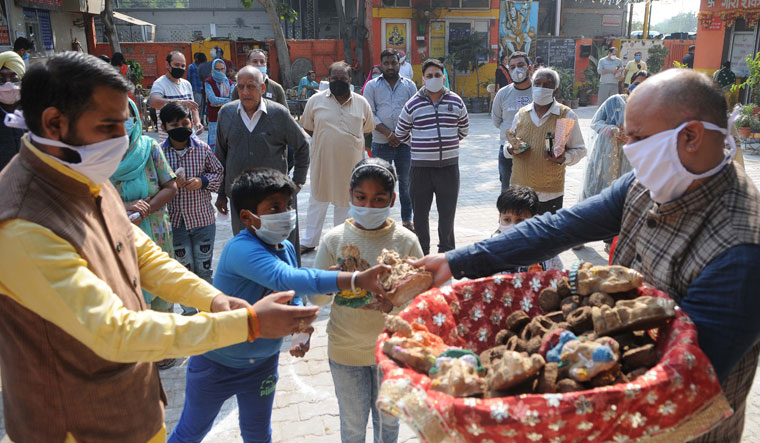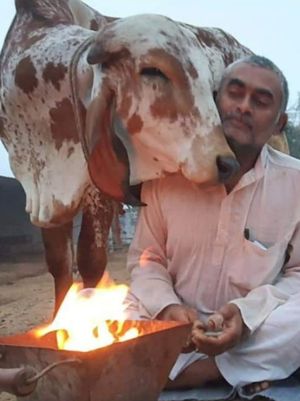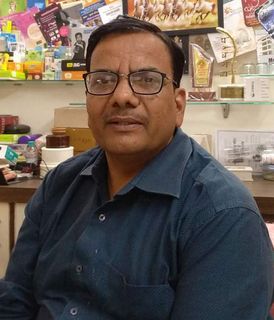On December 9, 2020, Karnataka Animal Husbandry Minister Prabhu Chauhan tabled the Prevention of Slaughter and Preservation of Cattle Bill in the lower house of the state legislature. While the legislative assembly passed the bill, the upper house, the legislative council, stalled it. Undeterred, the government issued an ordinance on December 28, banning slaughter of “cow, calf of a cow, bull, bullock, and he or she buffalo below the age of 13 years”. Violations will now attract imprisonment for three to seven years and penalties of Rs50,000 to Rs7 lakh. Repeat offenders will have to pay higher penalties up to Rs10 lakh.
For the BJP, the new law is a fulfilment of an old poll promise. The opposition Congress, however, has described the ordinance as “communal” and “politically motivated”. Cow protection groups say the law would discourage cattle theft, smuggling and illegal slaughter houses. Critics say it would lead to social conflict and saddle the farmer with “unproductive” cattle.
Opposition leader Siddaramaiah said the bill was intended to create “communal tensions” and cause suffering to dalits and Other Backward Classes. He dared the Union government to enforce a similar law across the country, including in Kerala, Goa and the northeast, where a large number of people consume beef. The former chief minister, however, seems to be isolated within his party, the Congress. Not many Congress leaders have criticised the ordinance; perhaps they do not want to anger voters who regard the cow as sacred.
“No farmer wants to sell cattle to butchers, so the government must set up shelters and buy unwanted cattle from the farmer,” said Sachin Meega of Karnataka Kisan Congress. “It is a blind bill and a political gimmick by the BJP. Why is the government allowing slaughter of cattle above 13 years? If cow protection is meant to safeguard rural economy, impose a total ban on slaughter. The [ordinance] creates confusion and paves the way for conflicts between cow vigilantes and cattle traders.”
Former chief minister H.D. Kumaraswamy said laws should protect both cattle and farmers. “Poor farmers cannot feed male calves, or aged, ailing or unproductive cattle,” he said. “The economic burden will eventually drive them away from dairy farming. The ordinance insists on [official] permits and certification by veterinary doctors to slaughter cattle. This will lead to licence raj and corruption.”
According to Livestock Census 2019, the total bovine population in India is 302.79 million, an increase of 1 per cent over the previous census in 2012. The total number of cattle is 192.49 million, an increase of 0.8 per cent. There are 145.12 million cows (up 18 per cent). Some 142.11 million cattle are indigenous breeds and 50.42 million are exotic or crossbred. While indigenous cattle have decreased by 6 per cent, exotic and crossbred cattle have increased by 26.9 per cent. There are 109.85 million buffaloes, an increase of about 1 per cent.
What effect will the slaughter ban have on the bovine population? Experts say it could be of little help if farmers are not made aware of the utility of cattle. “We need to move away from the milk-centric cow economy and reintegrate cattle into the Indian way of farming, as cow dung is still the best manure,” said Sunil Mansinghka, chief coordinator of the Nagpur-based research centre Go Vigyan Anusandhan Kendra. “The non-milch cattle will also be an asset when we create and market products made of panchagavya (a mixture of cow dung, cow urine, milk, curd and ghee). It strengthens rural economy, creates local employment and popularises environment-friendly farming practices that ensure safe food, water and air.”
Non-milch cattle are not a burden, said Sinu Joseph, a Bengaluru-based social activist who promotes chemical-free farming. “It is political propaganda to say the slaughter ban burdens the farmer or deprives someone of their choice of food,” she said. “Goseva is part of Indian culture and ethos. Cow is central to Indian agriculture and rural life. Slaughtering a non-milch cow has never been an option to the farmer, as cow dung and cow urine enhance soil fertility. Zero-budget farming and organic farming cannot exist without the desi cow.”
An RSS member, Joseph recently launched Subhiksha Farmers to Consumers, a cooperative society that promotes organic farming and connects farmers and consumers in 15 districts in Karnataka. She said consumption of beef and processed milk posed health hazards. “Humans are not designed to digest [the meat of] larger animals, especially red meat. Studies show beef-consuming states have higher incidence of stomach and colon cancer,” she said. “On the other hand, our dairy farming has the wrong approach. Exotic breeds of cow like the Holstein Friesian and the Jersey yield more milk and are treated as milk-vending machines.” She said companies were collecting milk from villages and adding preservatives to store it. They were removing milk cream to make butter and value-added milk products, and then processing them for distribution. “This milk is not rich in nutrients,” she said. “Chemicals used in dairy milk are responsible for early puberty, too. We need a farmers’ cooperative, where the farmer directly provides raw and nutritive milk to the consumer.”
The expanding market for organic milk and milk products has led to religious mutts, spiritual gurus and NGOs taking up dairy farming, building brands and marketing their products. The latest trend, however, is the village-level enterprise that can help create value for cattle, preventing them from being sold for slaughter. Cow entrepreneurs lament that in agriculture today, cattle no longer play a central role: chemicals have replaced organic manure, and mechanisation has reduced the involvement of bulls and bullocks in farming.
Many people want a change in the milk-centric economic model of dairy farming. “A boost to the panchagavya industry will help build Atmanirbhar Bharat,” said Neeraj Chaudhary of Kashipur in Uttarakhand. A 30-year-old entrepreneur and postgraduate in social work, Chaudhary has been educating people on how to develop cattle-centric businesses. His startup, Sri Bansi Gau Dham LLP, produces cow dung-based slippers, tiles, clocks, cellphone covers, oil lamps, idols and electrical panels.
Chaudhary was running a pan masala business a year ago when he read the book Devil in the Milk: Illness, Health and the Politics of A1 and A2 Milk by a New Zealand-based researcher, Keith Woodford. The book examines the link between A1 beta-casein (a milk protein produced by cows in the US, Europe, Australia and New Zealand) and heart disease, type 1 diabetes, autism and schizophrenia. According to Woodford, milk without A1 beta-casein, called A2, is healthy and beneficial. Devil in the Milk is hugely popular among cow entrepreneurs in India. “It changed my perspective and I decided to work with desi cows,” said Chaudhary.
He completed short-term courses in entrepreneurship development at the Indian Veterinary Research Institute, Bareilly, and Indian Institute of Management Kashipur. “I started buying dry cow dung from local farmers who had been selling only milk. My products utilise gobar, medicinal roots and herbs, and natural binding agents like resins. I designed and perfected each product and trained around 20 local youth. During festivals, we get bulk orders and make Ganesh idols. It is a good model: a farmer can invest Rs500 and make Rs5,000 from 100 idols using locally available cow dung.”
Chaudhary said the market would expand once consumers realised the benefits. “We are mindful of what we use in our product, and have been successful in replacing harmful and expensive raw material like plaster of Paris, plastic and leather,” he said.
Chaudhary was part of the ‘cow cabinet’ constituted by the Madhya Pradesh government last year for the protection and promotion of cattle. “Nandi (the bull) represents shakti (power) and it is wrong to conclude that it is a burden,” he said. “Many cow startups are utilising bulls to run manual chakkis (mills), which work as flour mills and power mills.”
Rameshbhai Rupareliya of Rajkot in Gujarat has had an entrepreneurial journey worthy of a Bollywood film. Fifteen years ago, a financial crisis forced the Rupareliyas to sell off farmland and jewellery. They were left with a lone cow and two bulls. The family survived on leftover food during the wedding season. In 2010, Ramesh rented a 10-acre farm and grew onions using cow dung. The bumper harvest earned him Rs35 lakh, and he purchased four acres in nearby Gondal village.
Today, Rupareliya is a role model for aspiring cattle entrepreneurs. He runs a cow shelter, the Gir Gau Jatan Sanstha, and exports 80 cow-based products to 130 countries. His annual turnover is Rs3 crore. “My target is to earn $30,000 a month in the next six months,” he said. “It sounds impossible, but not to me. I firmly believe that only a non-exploitative business thrives.”
A year after he purchased land in Gondal, he harvested 26 tonnes of turmeric. Local farmers gathered at his farm to learn about his business model. “I offered to train them for a fee,” he said. “My growing herd of 200 Gir cows in my shelter was fuelling my growth. I launched a YouTube channel to train farmers in organic farming; it has had three crore views. Last month, I launched an app on cow breeding (Vedic Gaupalan Vidya) in 12 languages; it has 6,000 users. I have demonstrated how cow-based businesses can help earn Rs50 lakh on an acre of land. It needs a multi-dimensional approach to utilise the panchagavya.”
According to Rupareliya, only like-minded people could steer a cow-based economy. That, he said, was why he launched a matrimonial service for gopalaks (cattle rearers). “Protection of desi breeds is crucial to building a cow-based economy. I realised that unless both partners are gopalaks the cause cannot be strengthened. So I launched the matrimonial service.”
Bheem Raj Sharma of Babru village in Rajasthan holds a patent for making paper from cow dung. His organisation, Gaukriti, makes envelopes, wedding cards and notebooks. Gaukriti has eight distributors across India and exports its products to the US and the UK. With an annual turnover of Rs1 crore, it helps run a cow shelter that protects 8,000 cattle.
“The paper is environment friendly as it helps save trees,” said Sharma. “It takes 17 trees to make one tonne of paper. We are manufacturing paper with cow dung, cow urine and cotton waste.”
His daughter Jagruti, a visual arts student, assists him at Gaukriti. The paper patent, he said, ensured that raw material is sourced only from indigenous breeds. “Till recently, people found it hard to believe that cow dung can be monetised. But our model is easily replicable. It is also the easiest way to double farmer income,” said Sharma. “Farmers feel that it is milk that brings cash; but we believe cow milk is for the calf. Instead of relying on milk, farmers must rely on cow dung and cow urine to earn a steady income.”
In 2019, the Union government constituted a national commission, the Rashtriya Kamdhenu Aayog, to organise animal husbandry on modern and scientific lines. “A people’s movement can reinstate cattle to its rightful place in the rural economy,” said Mansinghka, who is a member of the Aayog. “Policy intervention to boost cow-based economy is inevitable as the government is buckling under [the burden of] fertiliser subsidies. Farmlands are turning into barren lands because of excessive use of chemicals. The current system of farming is water-intensive, leading to depletion of groundwater. We have launched the Gau Gram Yojna in collaboration with NGOs to help farmers embrace organic farming. It can revitalise soil and enhance productivity.”
Pureesh Kumar, the Aayog’s IT and media in charge, said efforts were on to educate farmers and consumers about cow-based products. In 2020, the Aayog ran campaigns to promote Ganesha idols and diyas (earthen lamps) made of cow dung. He said 40 crore diyas were sold. The campaigns, he said, brought together 75 cow entrepreneurs to innovate, collaborate and market cow dung-based products. The Aayog plans to start cow hostels in cities, allowing every family to own a cow through sponsorship and get fresh milk and other products at their doorstep.
Entrepreneurs want the government to procure products and provide linkages to the open market. They plan to produce gobar briquettes for the boiler industry, gobar logs for crematoriums, and organic phenyls for cleaning public toilets and rail and bus stations, and replace diesel and petrol with biofuel.
But, a sustainable economic model for making cow shelters self-reliant is still proving elusive. The stray cattle menace, too, needs to be addressed urgently. While stray cattle in cities are a civic nuisance, they cause havoc in villages by feasting on standing crops.
In 2017, after India’s first cow sanctuary housing 4,000 cows came up in Agar Malwa in Madhya Pradesh, Rajasthan cow minister Otaram Dewasi signed a memorandum of understanding to set up a similar sanctuary in Bikaner. But similar projects elsewhere have been moving at a snail’s pace owing to paucity of funds and skilled workforce.
Madhava Goshala in Kalaburgi in Karnataka, perhaps, holds the answer. It is the first cow shelter in the state to get an ISO certification. “Two years ago, I started the cow shelter in a rented shed,” said Mahesh Bidarkar, assistant professor at Government Degree College in Kalaburgi. “Today, it is home to more than 103 injured, diseased, old, abandoned and rescued cattle.”
He and his team developed a range of products—vermicompost, bio-pesticide, herbal phenyl (using distilled cow urine and pine oil) and dishwashing powder—and made the shelter self-reliant. “Often, cow shelters are crowded, as farmers abandon non-milch cattle,” said Bidarkar. “When farmers borrow our healthy cattle for farming, it lessens the burden on us. They need to be educated on how cattle can support them financially.”





